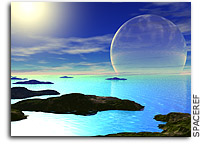New evidence suggests early oceans bereft of oxygen for eons

Early life may have lived very differently than life today
Arlington, Va.-As two rovers scour Mars for signs of water and
the precursors of life, geochemists have uncovered evidence that
Earth’s ancient oceans were much different from today’s. The
research, published in this week’s issue of the journal Science,
cites new data that shows that Earth’s life-giving oceans
contained less oxygen than today’s and could have been nearly
devoid of oxygen for a billion years longer than previously
thought. These findings may help explain why complex life barely
evolved for billions of years after it arose.
The scientists, funded by the National Science Foundation (NSF)
and affiliated with the University of Rochester, have pioneered a
new method that reveals how ocean oxygen might have changed
globally. Most geologists agree there was virtually no oxygen
dissolved in the oceans until about 2 billion years ago, and that
they were oxygen-rich during most of the last half-billion years.
But there has always been a mystery about the period in between.
Geochemists developed ways to detect signs of ancient oxygen in
particular areas, but not in the Earth’s oceans as a whole. The
team’s method, however, can be extrapolated to grasp the nature
of all oceans around the world.
“This is the best direct evidence that the global oceans had less
oxygen during that time,” says Gail Arnold, a doctoral student of
earth and environmental sciences at the University of Rochester
and lead author of the research paper.
Adds Enriqueta Barrera, program director in NSF’s division of
earth sciences, “This study is based on a new approach, the
application of molybdenum isotopes, which allows scientists to
ascertain global perturbations in ocean environments. These
isotopes open a new door to exploring anoxic ocean conditions at
times across the geologic record.”
Arnold examined rocks from northern Australia that were at the
floor of the ocean over a billion years ago, using the new method
developed by her and co-authors, Jane Barling and Ariel Anbar.
Previous researchers had drilled down several meters into the
rock and tested its chemical composition, confirming it had kept
original information about the oceans safely preserved. The team
members brought those rocks back to their labs where they used
newly developed technology -called a Multiple Collector
Inductively Coupled Plasma Mass Spectrometer-to examine the
molybdenum isotopes within the rocks.
The element molybdenum enters the oceans through river runoff,
dissolves in seawater, and can stay dissolved for hundreds of
thousands of years. By staying in solution so long, molybdenum
mixes well throughout the oceans, making it an excellent global
indicator. It is then removed from the oceans into two kinds of
sediments on the seafloor: oxygen-rich and those that are oxygen-
poor.
Working with coauthor Timothy Lyons of the University of
Missouri, the Rochester team examined samples from the modern
seafloor, including the rare locations that are oxygen-poor
today. They learned that the chemical behavior of molybdenum’s
isotopes in sediments is different depending on the amount of
oxygen in the overlying waters. As a result, the chemistry of
molybdenum isotopes in the global oceans depends on how much
seawater is oxygen-poor. They also found that the molybdenum in
certain kinds of rocks records this information about ancient
oceans. Compared to modern samples, measurements of the
molybdenum chemistry in the rocks from Australia point to oceans
with much less oxygen.
How much less oxygen is the question. A world full of anoxic
oceans could have serious consequences for evolution. Eukaryotes,
the kind of cells that make up all organisms except bacteria,
appear in the geologic record as early as 2.7 billion years ago.
But eukaryotes with many cells-the ancestors of plants and
animals- did not appear until a half billion years ago, about the
time the oceans became rich in oxygen. With paleontologist
Andrew Knoll of Harvard University, Anbar previously advanced the
hypothesis that an extended period of anoxic oceans may be the
key to why the more complex eukaryotes barely eked out a living
while their prolific bacterial cousins thrived. Arnold’s study
is an important step in testing this hypothesis.
“It’s remarkable that we know so little about the history of our
own planet’s oceans,” says Anbar. “Whether or not there was
oxygen in the oceans is a straightforward chemical question that
you’d think would be easy to answer. It shows just how hard it
is to tease information from the rock record and how much more
there is for us to learn about our origins.”
Figuring out just how much less oxygen was in the oceans in the
ancient past is the next step. The scientists plan to continue
studying molybdenum chemistry to answer that question, with
continuing support from NSF and NASA, the agencies that supported
the initial work. The information will not only shed light on
our own evolution, but may help us understand the conditions we
should look for as we search for life beyond Earth.
NSF Program Contact: Enriqueta Barrera, ebarrera@nsf.gov, (703)
292-8550
National Science Foundation: Cheryl Dybas, cdybas@nsf.gov ,
(703)292-7734
University of Rochester: Jonathan Sherwood,
jonathan.sherwood@rochester.edu , (585)273-4726









